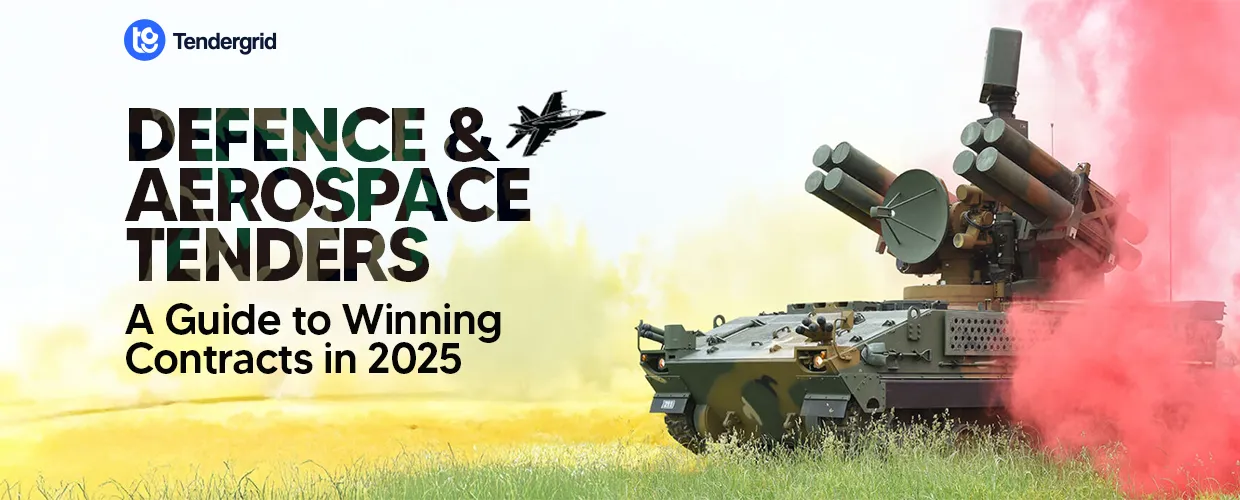In 2025, for the unmatched growth of the international defence and aerospace industry, various factors play an important role. Continuously increasing geopolitical tensions, high-speed innovation happening in technology, and national and regional security commitments all play a part in this. Nowadays, governments and international defence forces depend upon formal procurement processes. This helps obtain advanced technology, advanced weapon systems, and critical support services.
For companies looking to enter this high-stakes arena, it's a challenge and an opportunity to navigate the intricate sphere of Defence Tenders, Aerospace Tenders, and War Weapons Tenders. It takes the business the right information and platforms, like Tender Grid, to be positioned to win business for long-term, high-value contracts.
Understanding the 2025 Defence Procurement Landscape
Recently, the defence procurement system has majorly evolved. A significant shift in the tender issuing process through defence and aerospace agencies is reflected in the year 2025. This shift can be seen through, how these agencies favour innovation, automation, and resilience over traditional supply metrics.
Key trends include:
- Integration of AI, machine learning, and autonomous systems in battlefield technologies
- A surge in space defence and surveillance programs
- Increased demand for cybersecurity solutions and electronic warfare systems
- Emphasis on sustainability and local sourcing in defence manufacturing
This shift is also evident in government-issued Defence Procurement Tenders, which now demand higher levels of compliance, innovation, and international collaboration.
Major Categories in Defence & Aerospace Tenders
To formulate an unbeatable strategy related to the tendering process, it is essential that you get an understanding of the essential tender categories. Major categories that dominate defence and aerospace bids include:
- Aerospace and Aircraft Systems: This includes fighter jets, UAVs, space-based sensors, and navigation systems
- War Weapons & Ammunition: Includes Missiles, artillery systems, rifles, and integrated weapon platforms
- Surveillance & Communications: In this category, Radar systems, encrypted communication networks, and satellite technology are included
- Cyber Defence Solutions: Data encryption, threat detection systems, and digital warfare tools are inhibited
- Support Services: Maintenance, repair, logistics, and training for defence personnel are included in this
Special technical knowledge is required for all of these categories. This also requires proven experience in operations and quality certifications.
Leveraging Tender Grid for Strategic Tender Access
When it comes to the securing of a government tender, the Tender Grid plays an important role. This platform first helps in identifying the right opportunities. This is a specially curated e-procurement platform which provides relevant real-time tender information to the suppliers.
Tender Grid increases your tendering capabilities, which can be explained through these features:
- Curated Tender Listings: Users can access global Defence and Aerospace Tenders on a single platform, through daily updates.
- Targeted Search Filters: Searches can be refined and filtered through product category, region, budget, or funding agency.
- Submission Management: Users can get information regarding documentation, deadlines, and updates through a centralised dashboard.
- Smart Alerts & Notifications: Interested users can stay informed of new opportunities in specific defence segments. Information regarding War Weapons Tenders or space-based systems can be accessed.
Tender Grid helps businesses in enhancing not only their visibility but also their efficiency. This platform enables smarter and more quick decisions that align with relevant cycles of procurement.
Best Practices: Building a Winning Defence Tender Strategy
If you are someone who is interested in securing an opportunity in the defence or aerospace sector, you need to fulfil certain essentials. Since it is a multi-level process it demands precision, compliance, and strategic differentiation. The following are the essential components that you need to apply for a successful bid:
1. Thoroughly Interpret the Tender Scope
Before submitting a bid, review all documentation and gather detailed information. Go through all the technical specifications, eligibility criteria, and evaluation techniques, for better results.
2. Emphasize Technical & Operational Capabilities
In order to fulfil the expectations and stand out among the others, showcase your company’s abilities. This can be done by quoting relevant case studies, previous performance metrics, relevant certifications, and important references.
3. Emphasize Compliance & Risk Management
The organisation must comply with all the regulatory standards, which include:
- ISO 9001/27001
- ITAR (International Traffic in Arms Regulations)
- CMMC (Cybersecurity Maturity Model Certification)
4. Price Strategically, Not Aggressively
Try mentioning the deliverables, warranty, and continued services with clarity. No matter cost is an essential factor, but defence buyers prioritise reliability, lifecycle value, and post-deployment maintenance.
5. Avoid Common Pitfalls
- Incomplete documentation or unclear technical responses
- Overstated capabilities without evidence
- Non-compliance with procurement rules or timelines
By mastering these fundamentals, bidders significantly enhance their credibility and win potential.
Certifications, Partnerships & Eligibility Considerations
Winning Defence Procurement Tenders often hinges on pre-qualifications and strategic alignments. Essential factors for strategic winning include:
- Relevant Certifications: The company or the business must have ISO certification, quality assurance certifications, and security clearances.
- Joint Ventures & Strategic Alliances: Through the company’s partnership with local or global businesses, eligibility requirements can be fulfilled, and technical offerings can be strengthened.
- Local Manufacturing or Assembly Capabilities: Some tender opportunities give priority to the bidders who follow the local manufacturing process, such as “Make in India” or other national initiatives.
Your company or organisation can become more credible, reliable and contract ready, through the help of these factors.
The Future of Defence & Aerospace Tendering
Currently, innovation and geopolitical collaboration are responsible in shaping the tender process in defence and aerospace. Below are the categories that are likely to experience exceptional growth:
- AI-Enabled Warfare & Predictive Intelligence Systems
- Sustainable Defence Technologies (e.g., electric military vehicles)
- Space-Based Defence Infrastructure
- Multinational Procurement Programs
Seize the Opportunity in 2025
Various high-value procurement opportunities are ready to streamline the challenges in Defence and aerospace contracting in 2025, with planning and precision. No matter in which category you are specializing. Be it war systems, aerospace parts, or infrastructure in cybersecurity, your success in each of these depends upon the quality of information you are receiving and the actions you are taking on that basis.
Tender Grid assists you in gaining access to information related to global Defence Tenders. It helps with comprehensive tools and real-time updates that can change your procurement process. This platform helps you in achieving an extra edge in an industry defined by trust, quality, and performance, through the right tools and strategies.
So, what are you waiting for? Kickstart your journey in defence procurement with Tender Grid, and become one of the important parts in the future of national and global security.

